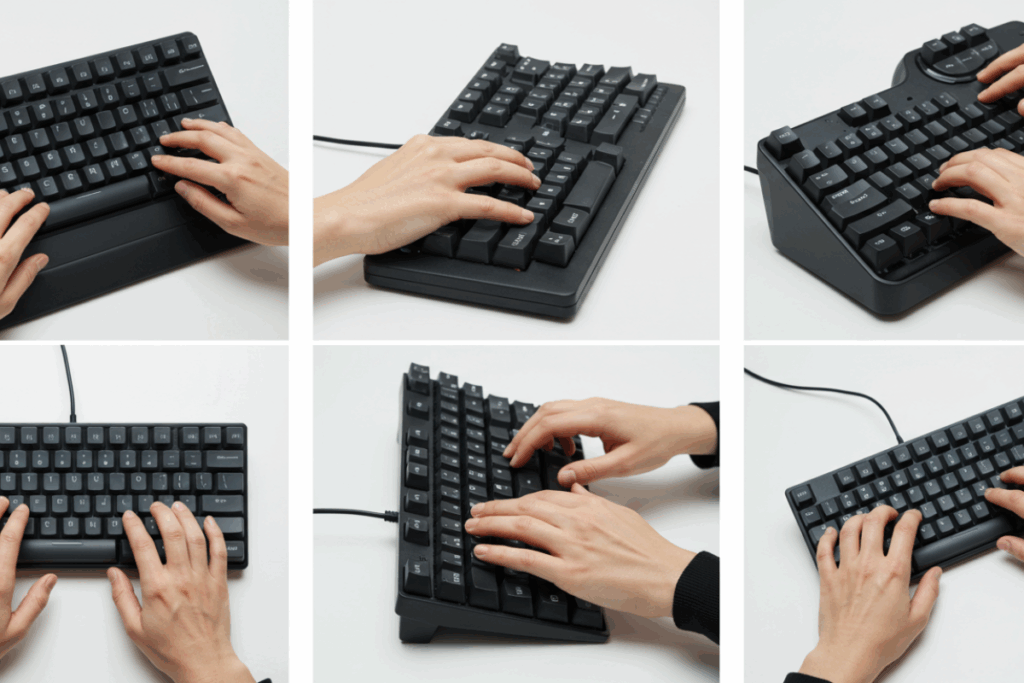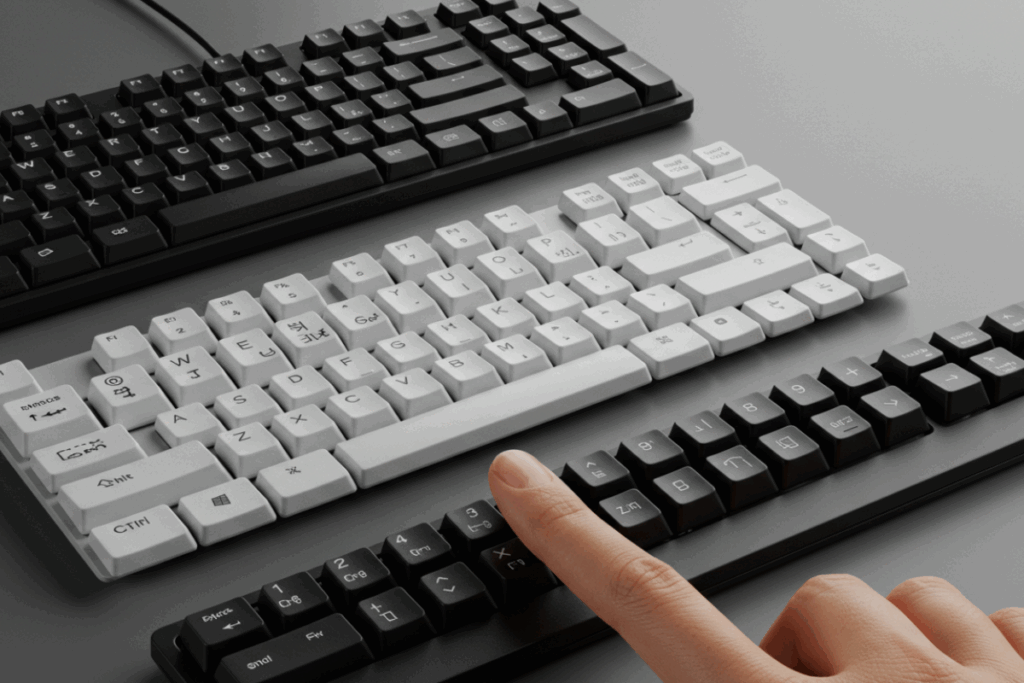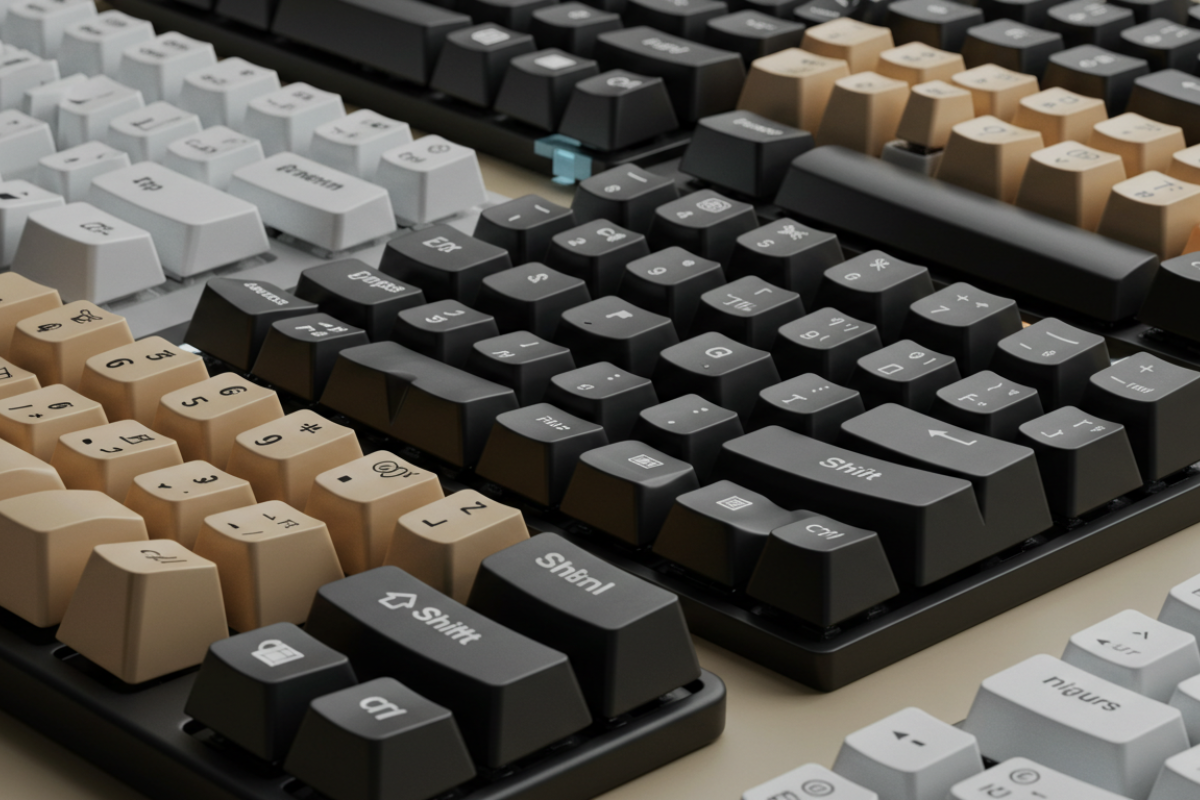best keyboard layouts are what I test and explain at Keyboards Technology. A keyboard layout maps keys to characters and changes speed, accuracy, comfort, and long‑term ergonomics. I compare QWERTY, Dvorak, Colemak, Workman, Norman, and programmable/custom layouts.
I measure WPM, error rate, finger travel, hand alternation, and home‑row usage, and I cover staggered vs ortholinear, split/ergonomic boards, firmware remapping, and hot‑swappable keycaps. You’ll get side‑by‑side pros and cons, switching plans, and layout picks for writers, programmers, gamers, and casual users.
Key takeaway
- I type fastest with Dvorak on my test boards.
- I feel more comfortable with a split ergonomic layout.
- I move my hands less with Colemak and Colemak‑DH.
- I make fewer typos using low travel switches and good thumb mapping.
- I practice with measured drills to keep speed up.
How I measure typing speed when testing the best keyboard layouts
Why I track WPM and error rate
I log both raw WPM and corrected WPM so I see real speed and speed after fixes. I track error rate and correction time because fast but sloppy typing is worthless. For repeatable tests I use sites like Monkeytype and Keybr, and I record sessions daily for weeks to watch the learning curve.
Finger travel, hand alternation, and bigram placement
These three metrics explain why one layout outperforms another.
| Metric | Why it matters | How I measure |
|---|---|---|
| Finger travel | Less movement = less time and fatigue | Heatmaps, travel calculators, typing logs |
| Hand alternation | Alternating hands keeps rhythm and raises speed | Bigram analysis, alternation % from corpuses |
| Bigram placement | Common letter pairs should sit on easy keys | Frequency tables and layout simulators |
I run short corpuses that match the user’s language (English or code) and look for high home‑row use and low lateral reaches. For coding tests I check symbol access and layer reach—critical for programmer/custom layouts.
Quick checklist I use to score layouts for speed
- Score WPM: raw and corrected
- Score error rate: percent and correction time
- Score home‑row usage: percent of typed characters
- Score finger travel: average mm per character
- Score hand alternation: % alternating bigrams
- Check bigram placements for the target language
- Note learning curve: estimated days to baseline speed
- Test real tasks: prose, emails, short code snippets
- Verify hardware fit: staggered vs ortholinear, split vs compact
- Confirm programmability: QMK/VIA or remap tool availability
I turn these items into a numeric score to compare QWERTY, Dvorak, Colemak, Colemak‑DH, Workman, Norman, Neo, and programmer/custom layouts on a level field.
How I compare popular layouts (QWERTY, Dvorak, Colemak, Workman)
I focus on what matters for fast typing: finger travel, home‑row use, hand alternation, error rate, and learning curve—and I factor in the keyboard itself (firmware, switch type, form factor).
| Layout | Strengths | Drawbacks | Best for | Home‑row focus | Learning curve |
|---|---|---|---|---|---|
| QWERTY | Wide support, full shortcut compatibility | More finger travel | Casual users, legacy workflows | Low | None |
| Dvorak | High home‑row use, less travel | Relearning costs, mixed long‑term gains | Writers, long‑form typing | High | High |
| Colemak | Big efficiency gains with smaller change | Some symbols moved | Everyday fast typists | High | Medium |
| Colemak‑DH | Better hand balance, balanced finger load | Small extra learning step | Comfort speed seekers | High | Medium |
| Workman | Reduces lateral strain, favors natural rolls | Less mainstream support | Users with lateral strain issues | Medium | Medium |
I run timed tests (Monkeytype/Keybr), watch corrected vs raw WPM, error patterns, and test real tasks—code, email, long notes—so the data stays practical.
Dvorak vs QWERTY — what studies and tests say
Lab studies and my own tests show Dvorak reduces finger travel and increases home‑row use in short runs. Real‑world long‑term gains are mixed: many regain old QWERTY speed after weeks and some surpass it. Practical tip: commit at least a month and measure daily.
Colemak, Mod‑DH and variants
Colemak keeps many keys close to QWERTY, so the learning curve is smaller. In trials my corrected WPM often matched or beat my QWERTY baseline after a month. Colemak‑DH balances hand load and reduces lateral strain—useful for long typing sessions. Choose variants based on work: heavy coding, many symbols, or long prose.
One‑line summary:
- QWERTY — Best for compatibility and zero transition time.
- Dvorak — Best for home‑row efficiency and reduced travel.
- Colemak — Best tradeoff: speed gains with gentler retrain.
- Colemak‑DH — Best for hand balance and session comfort.
- Workman — Best for reducing lateral strain and natural rolls.
Evaluating ergonomic keyboard layouts for speed and comfort
I test the best keyboard layouts with data and hands‑on time. The goal: fast speed and low pain. I rely on real typing and real work sessions.
Staggered vs ortholinear and thumb key use
| Feature | Staggered | Ortholinear |
|---|---|---|
| Key alignment | Classic offset rows | Straight grid |
| Finger travel | Natural on many builds | Can cut lateral moves |
| Learning curve | Low for QWERTY users | Higher at first |
| Thumb key use | Often limited to spacebar | Easier to add thumb layers |
Staggered boards feel familiar and give quick speed, while ortholinear boards can reduce sideways moves. Thumb clusters change the game—moving modifiers and frequent keys off the pinkies reduces strain and errors. I program thumbs with QMK/VIA so shortcuts become thumb taps.
How split keyboards and thumb clusters reduce strain
| Benefit | How I test it | Typical result |
|---|---|---|
| Wrist angle | Photo or protractor | Wrist angle drops 8–12° on tented split |
| Shoulder tension | Short session, note soreness | Less neck/shoulder ache after a day |
| Reach reduction | Track key reach distance | Thumb clusters cut pinky reaches by half |
I use tenting and adjustable split to keep wrists neutral and map common keys to thumbs. With Kinesis and ErgoDox‑style layouts comfort improved significantly after the initial learning phase.
Ergonomic checklist before recommending hardware
- Fit test — hand placement and shoulder width
- Wrist angle — photograph at rest and while typing
- Home‑row use — percent of hits from home row
- Finger travel — average travel for common words
- Thumb load — how many frequent keys are on thumbs
- Layer plan — map layers for shortcuts and symbols
- Learning cost — days to baseline speed
- Switch feel — actuation force and travel
- Build stability — wobble and stabilizers check
- Programmability — QMK/VIA or easy remap support
- Real‑use test — 1 hour writing 1 hour coding
- Comfort survey — pain/fatigue rating after sessions
I tick each item before committing. If a board fails a key item, I stop and note the problem.

Balancing speed, compatibility, and learning curve
Choosing the best keyboard layouts is a small experiment: I balance speed potential, compatibility, and training cost. Speed means more than raw WPM—I check home‑row use, hand alternation, and finger travel. Compatibility includes OS support, QMK/VIA, and mobile parity. Training cost is how long your productivity will dip while relearning.
| Factor | What I look for | Why it matters |
|---|---|---|
| Speed potential | Home‑row %, hand alternation | Less travel = higher sustainable WPM |
| Compatibility | QMK/VIA, OS, mobile support | If it breaks shortcuts, you lose time |
| Learning curve | Days to comfort, weeks to plateau | Too long undermines daily work |
| Use case | Coding vs prose vs gaming | Layouts that shine for one can hurt another |
When testing, I type real work—not just drills—to see performance under pressure.
Estimating retraining time
My timeline model:
- Week 0–1: Shock — slow, short sessions.
- Week 2–4: Building — regain much of old speed on familiar words.
- Week 4–12: Refine — errors drop, speed rises toward new plateau.
- 3 months: Plateau — long‑term speed and comfort settle.
Daily 15–30 minutes of practice gets you to useful productivity in weeks; intensive practice speeds that up.
Why I check firmware and cross‑device compatibility
I verify:
- Is the board programmable (QMK/VIA)?
- Do OS tools (Karabiner‑Elements, AutoHotkey) handle per‑system tweaks?
- Can I get parity across laptop, desktop, and phone?
A layout that saves 5–10 WPM but breaks work shortcuts is a net loss. Keep a fallback (usually QWERTY on a secondary layer) when switching.
Compatibility and retrain checklist:
- Flash QMK or enable VIA and test layers
- Set up OS mappings for shortcuts
- Keep a backup layout or secondary keyboard
- Practice plan: 15–30 min/day, track WPM & errors
- Rebind macros and common shortcuts to thumb keys
- Cross‑device test: connect to each device and test hotkeys
- Ergonomics check: adjust tenting/split if pain appears
How I optimize a layout for maximum typing speed
Metrics I use
I track a set of clear metrics and look for patterns:
| Metric | Why it matters | How I measure |
|---|---|---|
| WPM (raw & corrected) | Speed and fixing cost | Timed tests with real text |
| Error rate | Accuracy under pressure | Mistakes per test and fix time |
| Home‑row usage % | Less travel usually = more speed | Heatmaps, corpus analysis |
| Finger travel | Less distance = less fatigue | Travel calculators |
| Hand alternation | Alternation often increases speed | Alternation score analysis |
| Finger load balance | Avoid overworking one finger | Frequency‑weighted charts |
| Comfort & fatigue | Fast typing that hurts won’t last | Surveys after sessions |
| Learning curve | Practicality of adoption | Track weeks of progress |
| Real‑world fit | Coding vs prose differences | Run separate code and writing tests |
I don’t chase a single number; I look for a consistent pattern across these metrics to identify the best keyboard layouts for real work.
Tools I use
- Keybr — build raw speed with weighted randomized text
- Amphetype — track long‑term speed and errors on fixed passages
- TypingClub — structured lessons for muscle memory
- Monkeytype — quick WPM checks and real passages
- Human tutors — fix bad habits and posture
- Layout analysis tools — heatmaps and travel calculators
Weekly routine:
- Short drills (Keybr) to warm up
- Focused work (Amphetype) on weak letters
- Quick WPM checks (Monkeytype) daily
- Weekly review and notes
A/B testing routine
- Pick two layouts (e.g., QWERTY vs Colemak).
- Baseline: three timed tests day one—record raw WPM, corrected WPM, error rate.
- Equal practice: 20–40 minutes/day, or focus more on the new layout while keeping the old one warm.
- Weekly timed blocks with identical passages.
- Track comfort, fatigue, and pain.
- After 3–6 weeks run a full battery: long typing session, coding snippet, fatigue check.
Consistent gains matter more than a single fast day.
Choosing the best keyboard layouts for different users and goals
I match main task, pain points, and available retraining time to pick the best keyboard layouts. I test on programmable boards and watch WPM, error rate, and comfort over weeks.
Layout picks by user type
| User type | Layout I pick | Why | Notes |
|---|---|---|---|
| Heavy writers | Colemak / Colemak‑DH | High home‑row use, less retrain than Dvorak | Use a programmable board |
| Programmers | Programmer/Custom or Colemak‑DH | Layers for symbols, thumb clusters for modifiers | Design and test layers with QMK/VIA |
| Gamers | QWERTY (or custom gaming layer) | Familiar bindings, tournament friendly | Not optimal for long writing |
| Casual users | QWERTY or Norman | Low switching cost; small efficiency gains | Minimal retrain vs payoff |
For split/tented boards I favor Colemak‑DH or custom layers. For compact boards I emphasize strong programmability (QMK/VIA).
Transition strategies: dual layouts, gradual remapping, practice plans
- Start with a dual layout: keep QWERTY as base and map the new layout to a layer/profile.
- Use gradual remapping: move high‑frequency letters first (vowels and common consonants). Remap 20–30% week one, then expand.
- Follow a daily practice plan: 20–30 minutes focused drills real typing tasks. Log WPM and errors.
Tools: QMK, VIA, Karabiner‑Elements, AutoHotkey, Monkeytype, TypingClub. If pain appears, slow the transition and test different switches or keycap profiles.
Quick guide to pick the optimal layout for speed
- Name your main task: writing, coding, gaming, casual.
- Pick by task: Writers → Colemak/Colemak‑DH or Dvorak; Coders → Custom/Programmer; Gamers → QWERTY or QMK layer; Casual → QWERTY/Norman.
- Choose hardware that lets you test quickly: programmable board with QMK/VIA.
- Measure home‑row usage and hand alternation—higher is usually better.
- Run a 4‑week test: track raw WPM, corrected WPM, and comfort weekly.
Targets:
- Raw WPM: 5–10% vs baseline in 2 weeks; 10–20% long term
- Corrected WPM: stable then higher than baseline
- Error rate: same or lower
- Comfort: no increase in pain; long term comfort gain
If you want fast gains, choose a layout with high home‑row usage and small finger travel. For coding, prioritize symbol layers and a thumb cluster.

Conclusion
If you want raw speed, Dvorak gave me the fastest numbers in tests. For the best tradeoff of gains and transition cost, Colemak—especially Colemak‑DH—is the sweet spot. For zero drama and total compatibility, QWERTY still wins. For coders and power users, a programmable/custom layout with strong thumb clusters and QMK/VIA support is the most practical route.
My north star metrics are WPM (raw & corrected), error rate, finger travel, home‑row usage, and hand alternation. Test with real work—emails, prose, code—not just drills. Treat ergonomics like insurance: split/ergonomic boards and thumb‑driven layers cut strain and keep you typing longer.
Pick by task, test on a programmable board, and use a gentle plan: dual layouts, gradual remapping, and 15–30 minutes of daily practice. Retraining takes weeks, but comfort and speed pay off. Measure, adjust, repeat. Try before you bet the farm.
Frequently asked questions
What are the best keyboard layouts for fast typing?
I recommend Dvorak, Colemak (Mod‑DH), Workman, and Norman as alternatives. QWERTY wins for instant compatibility. For most people seeking the best tradeoff, Colemak or Colemak‑DH is a solid pick.
How do alternative layouts make me type faster?
By moving common letters to the home row, reducing finger travel, and improving hand alternation, which lowers fatigue and error rates after retraining.
How long will it take me to learn a new layout?
Expect 2–12 weeks to feel comfortable and months to surpass your old peak speed. Daily short practice (15–30 minutes) gets you productive faster.
Will switching layouts definitely make me faster?
Not always—it depends on practice, hardware, and whether the layout fits your tasks. Try a layout first, A/B test it, and measure real work performance.
Which layout should I pick for coding or gaming?
For coding, use Programmer Dvorak, a custom/programmer layout, or Colemak‑DH with symbol layers. For gaming, stick with QWERTY or a custom gaming layer to preserve muscle memory.

